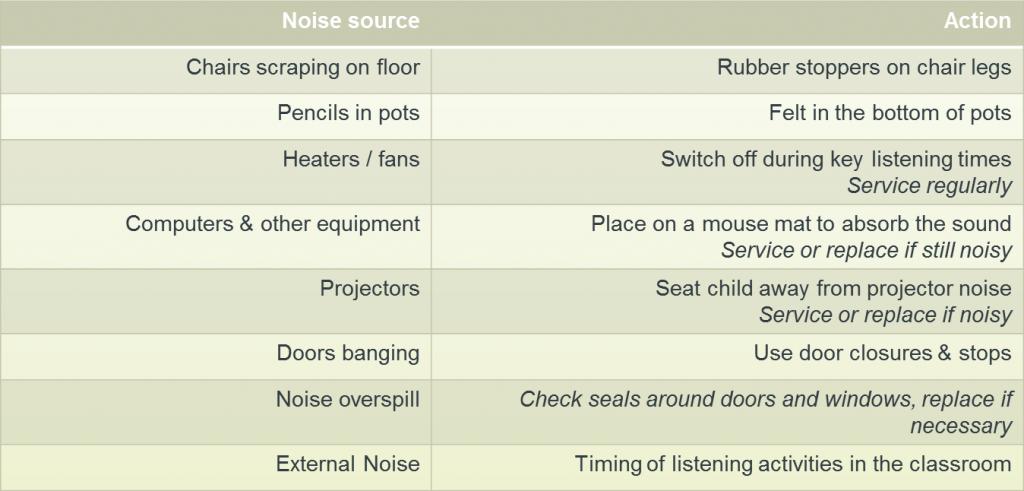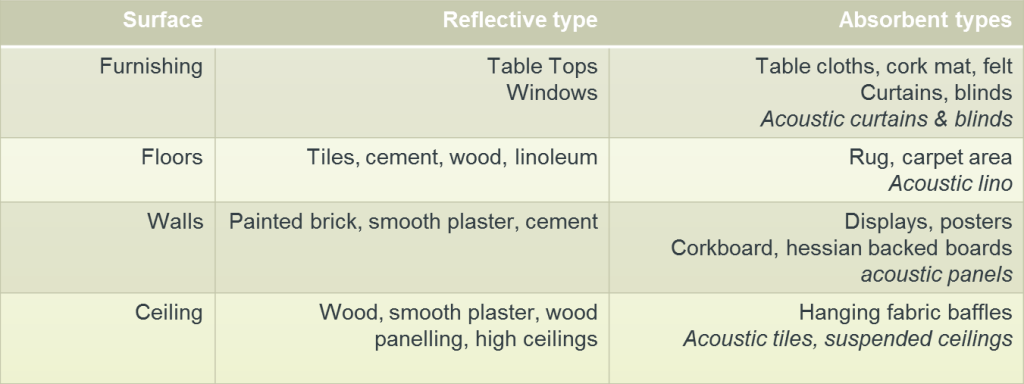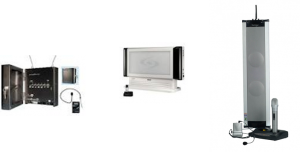Click on the tabs below to explore how we can help improve hearing in challenging listening environments.
1. Identifying and reducing noise sources external and internal
Click on the icons to find out more.

2. Changes to reduce reverberation
Click on the icons to find out more.

There are acoustic modifications to rooms and maintenance of buildings that will be outside your direct control but you could advocate for. Some of the ideas are more expensive than others, but the changes will significantly benefit all students and teaching staff. Some ideas and useful references are:
1. The statutory and advisory building regulations: The Education (School Premises) Regulations 2012
2. Acoustic design of schools: performance standards (Building Bulletin 93)
Please ask your local teacher of the deaf for the agency to contact in your area. It may involve an acoustic audit.
Look at practical suggestions to help, as suggested in The National Deaf Children’s Society’s resource for teachers.
3. Other support strategies could include:
- Using quiet areas
- Using a “traffic light” system to control noise levels of pupil talk, such as ‘Chatter Trackers’
- Using visual cues and clues
- Ensuring light on the face of the speaker
- Considering seating position of the child
- Reducing visual interference & distraction
- Restricting movement around the room
Below is a clip of a parent talking about the advice the local Teacher of the Deaf can give.
To hear an example of the difference it could make follow the link below.
http://www.comfortaudio.com/for-users/sound-demo/
Setting up Radio aids with cochlear implant processors – what should happen?
- Radio aids should be set up in line with UK FM Working Group (UKFMWG) Quality Standards for the use of personal radio aids : Promoting easier listening for deaf children (NDCS 2017) with particular reference to auditory implants.
- Radio aids do a fantastic job at helping a person to hear in noise but it is essential that they are set up correctly. Good communication between the professionals involved is important (Auditory Implant Centre audiologist and keyworker, local teacher of the deaf, parents, and all those involved in supporting the child). Each cochlear implant processor has a specific configuration with radio aid systems.
- When would a radio aid be fitted? As part of its fitting policy USAIS uses the Radio Aid CHIP (Adapted from LInked uP – London Consortium of ICTODs and Peris) with local staff and family to inform on child readiness for radio aid fitting.
- USAIS offers guidance on daily management including how to use, check and troubleshoot the system.
A note of caution: Re-broadcasting
Radio aid systems are carefully set up and balanced to the input of the average speakers voice at 15 cm. Anything plugged into the auxiliary input to the transmitter which is then rebroadcast to the child’s radio aid receiver could potentially be at a different input level. This could be too loud or quiet for that child. So a listening check using earphones to compare with listening using radio aid alone is needed. Your local teacher of the deaf can provide you with more guidance on this.
Soundfield systems
These are an increasingly popular system designed to improve listening conditions for all children in the classroom. It does this by providing a consistent level of sound from the primary source, usually the teacher, throughout the classroom.
The teacher will speak into a microphone and this will be relayed to a speaker or series of speakers around the room.

They are not a substitute for a radio aid system. They should be used in addition. Please ask your local teacher of the deaf or keyworker at the cochlear implant centre for advice on how to ensure that performance of the personal radio aid system is not compromised.
Key concepts
- What are optimal conditions for listening with a cochlear implant?
- What are the challenges of listening with an implant?
- What are the main factors which can affect the sound quality in a room or classroom?
- What can we do to help attending and listening?
